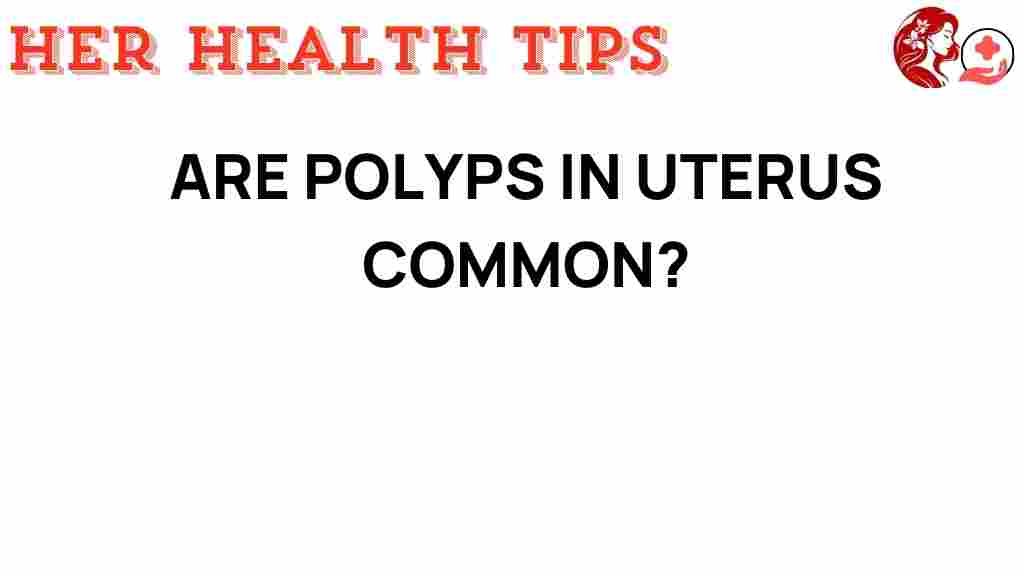Uterine Polyps: How Common Are They Really?
Uterine polyps are small, benign growths that develop on the inner lining of the uterus. They are considered a common issue in women’s health and can have various implications for reproductive health. In this article, we will explore the prevalence of uterine polyps, their symptoms, diagnosis, and treatment options. Understanding these factors can help women identify potential health issues early and seek appropriate care.
Understanding Uterine Polyps
Uterine polyps are made up of endometrial tissue and can vary in size from a few millimeters to several centimeters. While they are typically non-cancerous, their presence can lead to various health concerns.
Prevalence of Uterine Polyps
Uterine polyps are more common than many people realize. Research indicates that:
- Approximately 10-25% of women may develop uterine polyps during their reproductive years.
- They are more frequently diagnosed in women aged 40-50, often during the perimenopausal phase.
- Women with certain risk factors, such as obesity and hypertension, may have a higher prevalence of polyps.
Given these statistics, it’s clear that understanding uterine polyps is essential for maintaining optimal health and gynecology practices.
Symptoms of Uterine Polyps
Many women with uterine polyps may not experience noticeable symptoms. However, when symptoms do occur, they can include:
- Irregular menstrual bleeding
- Heavy or prolonged menstrual periods
- Bleeding between periods
- Bleeding after menopause
- Pain during intercourse
- Infertility issues
If you experience any of these symptoms, it is crucial to consult a healthcare professional for further evaluation.
Diagnosis of Uterine Polyps
Diagnosing uterine polyps typically involves a combination of medical history, physical examinations, and imaging studies. The following methods are commonly used:
- Pelvic Exam: A healthcare provider may perform a pelvic exam to check for any abnormalities.
- Ultrasound: Transvaginal ultrasound is often used to visualize the uterus and detect polyps.
- Hysteroscopy: This is a more definitive diagnostic tool where a thin, lighted tube is inserted into the uterus to directly visualize and possibly biopsy any polyps.
- Sonohysterography: This is a specialized ultrasound technique that involves injecting a saline solution into the uterus to provide a clearer image.
Regular check-ups and screenings can significantly aid in the early detection of uterine polyps, thereby enhancing women’s overall health.
Treatment Options for Uterine Polyps
The treatment for uterine polyps often depends on the severity of symptoms and the patient’s overall health. Options include:
- No Treatment: If the polyps are small and asymptomatic, doctors may recommend monitoring them.
- Medications: Hormonal medications may be prescribed to help regulate menstrual cycles and reduce symptoms.
- Surgical Removal: If polyps are large, symptomatic, or if there’s a concern about cancer, surgical removal may be necessary. This can be done through hysteroscopy.
Consulting with a specialist in gynecology is vital for determining the best treatment plan tailored to individual needs.
Step-by-Step Process for Managing Uterine Polyps
Managing uterine polyps involves a systematic approach:
- Consultation: Schedule an appointment with a gynecologist to discuss symptoms and concerns.
- Diagnosis: Undergo recommended diagnostic tests to confirm the presence of polyps.
- Discussion of Treatment Options: Work with your doctor to determine whether treatment is necessary based on your symptoms and health status.
- Follow-Up: After treatment, regular follow-up appointments are important to monitor for any recurrence of polyps or new growths.
Troubleshooting Tips for Managing Symptoms
For women experiencing symptoms related to uterine polyps, consider the following tips:
- Track Your Symptoms: Keep a diary of menstrual cycles, noting any irregularities in bleeding or other symptoms.
- Maintain a Healthy Weight: Since obesity can increase the risk of polyps, maintaining a healthy weight through diet and exercise is essential.
- Regular Check-Ups: Schedule regular gynecological exams to monitor your reproductive health.
- Discuss Medication Options: Talk to your healthcare provider about hormonal treatments that may help manage symptoms.
Taking proactive steps can significantly impact your women’s health and help manage the effects of uterine polyps.
Conclusion
In conclusion, uterine polyps are a common condition that many women experience, particularly during their reproductive years. Understanding the symptoms, diagnosis, and treatment options is crucial for maintaining both reproductive health and overall well-being. If you suspect that you may have uterine polyps or are experiencing related symptoms, do not hesitate to reach out to a healthcare professional.
For further information on women’s health topics, you may visit the Women’s Health Resource Center for additional resources. Always remember that early detection and treatment can make a significant difference in managing uterine polyps and enhancing your quality of life.
This article is in the category Reproductive and created by HerHealthTips Team
